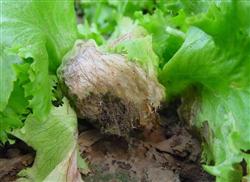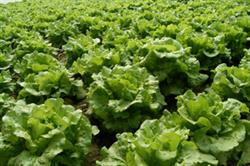Control techniques of Brown spot and Black spot of lettuce

Lettuce brown spot and black spot are considered to be mainly harmful to leaves. The leaf spot of brown spot shows two symptoms: one is water-stained at first, then gradually enlarged into round or irregular shape, brown to dark gray spot, ranging from 2mm to 10mm in diameter. Another kind is dark brown disease spot, the edge is irregular, the periphery has the water stain shape halo. Dark gray mildew occurs on the moist spots, and in severe cases, the disease spots merge with each other, until the leaves turn brown and dry. Black spot, also known as ring disease, leaf blight, forms round to nearly round brown spots on the leaves, and the size of the spot varies greatly under different conditions, generally 3mm to 15mm, brown to grayish brown, with concentric wheel lines, and no mildew can be seen in the field. Lettuce is planted annually in Guangdong, these two diseases can spread, spread and infect through seed disease and wind and rain. Generally warm and humid, rainy and foggy for a long time are conducive to the occurrence and prevalence of these two diseases. Insufficient soil fertility, poor growth of lettuce, or excessive application of nitrogen fertilizer will aggravate the disease. The following measures should be taken to control lettuce brown spot and black spot: (1) clean the countryside before soil preparation, apply appropriate amount of lime and sufficient organic base fertilizer after deep drying. (2) during the period of planting management, we should pay attention to rational irrigation, rational combination of nitrogen, phosphorus and potassium with topdressing, and spray foliar fertilizer such as phytoprotegerin, Lufengsu, etc., so as to make the plant grow healthily and improve the resistance. (3) We should pay close attention to spraying before the long seal of lettuce or at the early stage of the disease. the selected agents are: chlorothalonine or chlorothalonil (40% suspension) 600x, chlorozole (50% polysulfide wettable powder) 800g / 1000x, methyl topiramate or propofol (70% ultrafine compound wettable powder) 1000-1500 times, promethazine (50% wettable powder) 1500 times, Xinerpu (65% wettable powder) 400x, Baoning (60% Fuko wettable powder) 600,800 times. Spray once every 7 to 10 days, 2-3 times in a row.
- Prev

Symptoms and Control techniques of Botrytis cinerea in lettuce
A reader in Jiangsu asked, what are the symptoms and control methods of lettuce gray mold? Answer: Botrytis cinerea of lettuce mainly harms leaves and stems and can be infected from seedling stage to adult stage. Get sick at the seedling stage. The leaves and young stems rotted in the form of water immersion, and the diseased part was covered with gray mildew layer. The leaves are infected. Start with mature leaves near the ground.
- Next

High-yield cultivation techniques of lettuce
Lettuce seeds are grayish white or dark brown achenes, with a thousand seeds weighing about 0.8 to 1.2 grams. Before sowing, 70% dimethazone was used to treat the seeds at 0.3% of the seed weight. Lettuce seed germination requires a lower temperature, about 4 degrees Celsius seeds can germinate, so it can be sown in late March. Before sowing, the seedling bed was watered thoroughly.
Related
- Where is it suitable to grow horseradish in China? it is expected to see the middle altitude horseradish in Alishan.
- How to prevent tomato virus disease reasonably? (Control methods included)
- Many people like to plant towel gourd on the balcony. What are the main points of this method and management?
- What crops can chili peppers be mixed with?
- Fertilization techniques and matters needing attention in Tomato
- What are the grafting techniques for peach seedlings in spring?
- Harm and control methods of root swelling disease of Chinese cabbage
- What are the pests of sweet potatoes? How to prevent and cure it?
- Symptoms, causes and Control methods of navel Rot in Tomato
- The cause of "Cucumber rotten bibcock" in Farmers' planting Cucumber and its Control Plan

